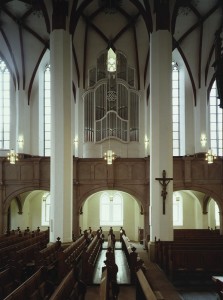Mira’s gravitation towards box sets continues, and today’s picks had to be pared down. She chose both the complete J.S. Bach organ works (17 discs) and the Miles Davis ‘Bitch’s Brew’ box set. Celia chose more Queen and Lou Reed… but due to the size of the Bach box I decided to put Miles, Queen and Lou Reed off until tomorrow.
The Bach set is one of two complete Bach organ works I have. The one from today is Peter Hurford’s London set. The different sets of compositions are also performed on organs throughout Europe. So in addition to hearing all of Bach’s organ works, you also get a great sense of how varied an instrument the organ can be. Organs are pretty unique instrument-wise. In some ways, they are like time-capsules. We know about how tuning has changed throughout history (since the pipes don’t easily go in and out of tune, unlike piano strings). It’s history goes back to the 3rd century B.C., and we can see in it’s key layout and construction how the concepts of scale and music theory evolved. It can be orchestrated, and a major part of the organist’s art is the control of registration. Yet, unlike a piano there is little control over dynamics. More stops will make things louder. More notes will make things louder. The swell box can make things louder. Hitting the keys harder – nothing. So when composing for the instrument the number of notes sounding can be an expressive as well as a textural consideration, and the organist can play with a touch that is most comfortable to them without worrying about how it will effect the dynamics of a performance.
During my time at UC Berkeley, I was lucky enough to have a class on Bach with Prof. John Butt, a wonderful teacher and organist. Watching him play was astonishing. His feet played as frantically as his hands did across multiple keyboards. As he came to new themes or sections in a piece, he would also change the stop configuration – the color and power of the instrument would change greatly just by pulling out a couple knobs. In Hertz Hall there were three organs (including a 17th century (?) Italian organ that sat right behind the double bass section on stage during orchestra rehearsals and concerts) and Prof. Butt’s favorite was situated above and behind the audience, which brings up another peculiarity of the instrument. While pianos rarely travel with a performer, concert organs NEVER do. An organist needs to learn the idiosyncrasies of each new instrument they come across for every performance. And you rarely get to SEE the performance. Organ lofts in churches weren’t designed so you could see the organ being played. They were often tucked away – and sometimes the organist might not even be able to hear the instrument well!
So to get a set like the Peter Hurford one is interesting on multiple levels. You get a tour of organs while also getting a tour of one of this instrument’s most amazing composers. I haven’t listened to this set for quite some time, and it is getting a little too late here to turn the volume to where it belongs. But I’m sure I’ll have more to say about these discs tomorrow after having some time to listen to it.


